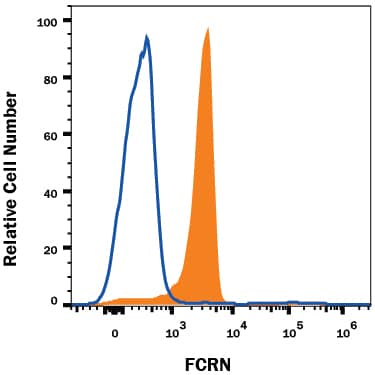Human FCRN Antibody
R&D Systems, part of Bio-Techne | Catalog # MAB8639


Conjugate
Catalog #
Key Product Details
Species Reactivity
Human
Applications
CyTOF-ready, Intracellular Staining by Flow Cytometry, Western Blot
Label
Unconjugated
Antibody Source
Monoclonal Mouse IgG2B Clone # 937508
Product Specifications
Immunogen
Chinese hamster ovary cell line CHO-derived recombinant human FCRN
Ala24-Ser297
Accession # P55899
Ala24-Ser297
Accession # P55899
Specificity
Detects human FCRN in direct ELISAs.
Clonality
Monoclonal
Host
Mouse
Isotype
IgG2B
Scientific Data Images for Human FCRN Antibody
Detection of Human FCRN by Western Blot.
Western blot shows lysates of THP-1 human acute monocytic leukemia cell line and HepG2 human hepatocellular carcinoma cell line. PVDF membrane was probed with 5 µg/mL of Mouse Anti-Human FCRN Monoclonal Antibody (Catalog # MAB8639) followed by HRP-conjugated Anti-Mouse IgG Secondary Antibody (Catalog # HAF018). A specific band was detected for FCRN at approximately 40 kDa (as indicated). This experiment was conducted under reducing conditions and using Immunoblot Buffer Group 3.Detection of FCRN in U937 Human Cell Line by Flow Cytometry.
U937 human histiocytic lymphoma cell line was stained with Mouse Anti-Human FCRN Monoclonal Antibody (Catalog # MAB8639, filled histogram) or isotype control antibody (Catalog # MAB004, open histogram), followed by Allophycocyanin-conjugated Anti-Mouse IgG Secondary Antibody (Catalog # F0101B). To facilitate intracellular staining, cells were fixed and permeabilized with FlowX FoxP3 Fixation & Permeabilization Buffer Kit (Catalog # FC012). View our protocol for Staining Intracellular Molecules.Applications for Human FCRN Antibody
Application
Recommended Usage
CyTOF-ready
Ready to be labeled using established conjugation methods. No BSA or other carrier proteins that could interfere with conjugation.
Intracellular Staining by Flow Cytometry
0.25 µg/106 cells
Sample: U937 human histiocytic lymphoma cell line fixed and permeabilized with FlowX FoxP3 Fixation & Permeabilization Buffer Kit (Catalog # FC012)
Sample: U937 human histiocytic lymphoma cell line fixed and permeabilized with FlowX FoxP3 Fixation & Permeabilization Buffer Kit (Catalog # FC012)
Western Blot
5 µg/mL
Sample: THP‑1 human acute monocytic leukemia cell line and HepG2 human hepatocellular carcinoma cell line
Sample: THP‑1 human acute monocytic leukemia cell line and HepG2 human hepatocellular carcinoma cell line
Reviewed Applications
Read 2 reviews rated 5 using MAB8639 in the following applications:
Formulation, Preparation, and Storage
Purification
Protein A or G purified from hybridoma culture supernatant
Reconstitution
Reconstitute at 0.5 mg/mL in sterile PBS. For liquid material, refer to CoA for concentration.
Formulation
Lyophilized from a 0.2 μm filtered solution in PBS with Trehalose. *Small pack size (SP) is supplied either lyophilized or as a 0.2 µm filtered solution in PBS.
Shipping
Lyophilized product is shipped at ambient temperature. Liquid small pack size (-SP) is shipped with polar packs. Upon receipt, store immediately at the temperature recommended below.
Stability & Storage
Use a manual defrost freezer and avoid repeated freeze-thaw cycles.
- 12 months from date of receipt, -20 to -70 °C as supplied.
- 1 month, 2 to 8 °C under sterile conditions after reconstitution.
- 6 months, -20 to -70 °C under sterile conditions after reconstitution.
Background: FCRN
References
- Baker, K. et al. (2009) Semin. Immunopathol. 31:223.
- Baker, K. et al. (2014) Front. Immunol. 5:408.
- Story, C.M. et al. (1994) J. Exp. Med. 180:2377.
- Ober, R.J. et al. (2001) Int. Immunol. 13:1551.
- Dickinson, B.L. et al. (1999) J. Clin. Invest. 104:903.
- Chaudhury, C. et al. (2003) J. Exp. Med. 197:315.
- Simister, N.E. and K.E. Mostov (1989) Nature 337:184.
- Kobayashi, N. et al. (2002) Am. J. Physiol. Renal Physiol. 282:F358.
- Praetor, A. and W. Hunziker (2002) J. Cell Sci. 115:2389.
- Zhu, X. et al. (2001) J. Immunol. 166:3266.
- Spiekermann, G.M. et al. (2002) J. Exp. Med. 196:303.
- Firan, M. et al. (2001) Int. Immunol. 13:993.
- Sarav, M. et al. (2009) J. Am. Soc. Nephrol. 20:1941.
- Akilesh, S. et al. (2008) Proc. Natl. Acad. Sci. 105:967.
- Vidarsson, G. et al. (2006) Blood 108:3573.
- Qiao, S.-W. et al. (2008) Proc. Natl. Acad. Sci. 105:9337.
Long Name
Neonatal Fc Receptor
Alternate Names
FCGRT
Gene Symbol
FCGRT
UniProt
Additional FCRN Products
Product Documents for Human FCRN Antibody
Product Specific Notices for Human FCRN Antibody
For research use only
